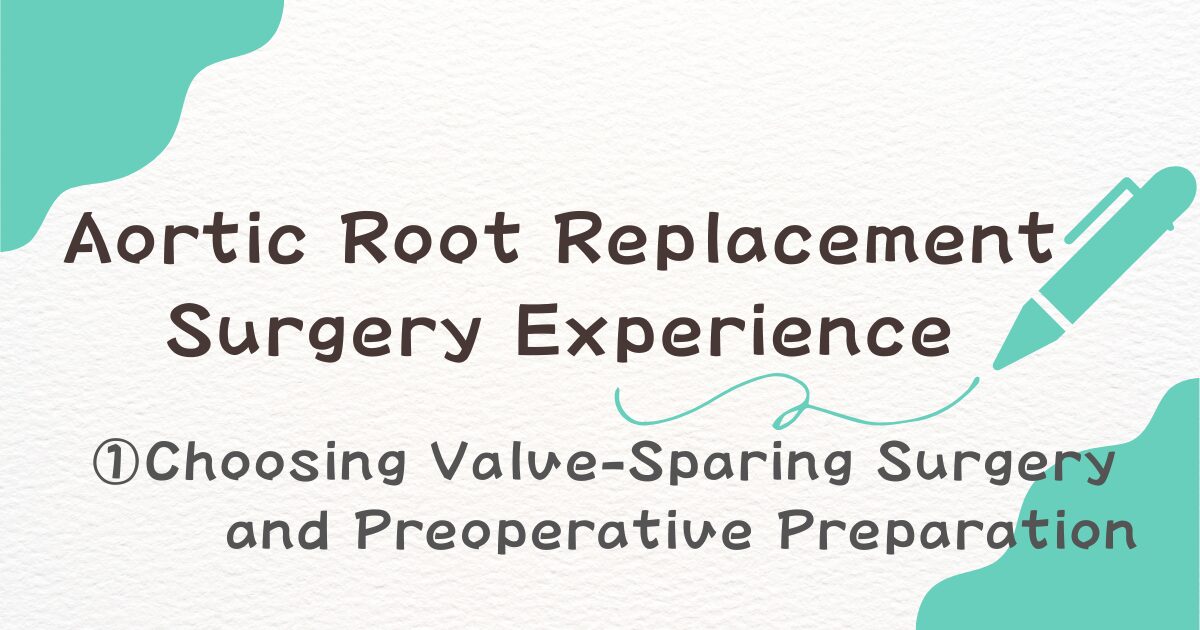Hello, I’m Mikan.
In this post, I’ll share my personal experience with aortic root replacement surgery. Since the content is extensive, I’m dividing it into two parts. In Part I, I’ll cover the selection of the surgical procedure and the preoperative preparations.
Choosing the Surgical Procedure
Before the surgery, my doctor provided me with a detailed explanation of the possible surgical options. Each procedure has its own advantages and disadvantages, and the choice is made based on the patient’s condition and personal preferences.
I underwent a valve-sparing aortic root replacement surgery. In this procedure, the patient’s own healthy aortic valve is preserved while the aortic root is replaced with a synthetic graft.
Below is a brief overview of the main surgical options:
- Valve-Sparing Surgery
By preserving your own valve, you can avoid taking warfarin for life. Warfarin is known for its teratogenic effects, making it less suitable for young women. However, depending on the durability of the native valve, a reoperation might be necessary in the future. - Aortic Root Replacement Using a Prosthetic Valve
- Mechanical Valve:
Offers high durability and is often chosen for younger patients, but it requires lifelong warfarin therapy. - Biological Valve:
Suitable for older patients or those who wish to avoid warfarin, though its durability is shorter compared to a mechanical valve.
- Mechanical Valve:
Even though there are many blood-thinning medications available, warfarin is considered superior when using a mechanical valve.
My first choice was valve-sparing surgery. However, as a precaution, I also pre-determined my backup plan—to opt for either a mechanical or a biological valve if preserving my own valve became unfeasible.
I chose the valve-sparing method partly because, even though I don’t currently plan on having children, I wanted to keep my future options open. I also didn’t want to limit my possibilities. I have always been reluctant to take warfarin due to its many drug interactions—it even meant I couldn’t eat natto! (Incidentally, even with the valve-sparing procedure, I took warfarin for about three months post-surgery.)
Preoperative Explanation and Examinations
As part of the surgical preparations, I received an explanation about the potential need for a blood transfusion, and I was asked to sign a consent form. Hearing that there was a high possibility of needing a transfusion made me realize just how major this surgery was compared to my previous ones, and I felt quite nervous.
For the preoperative examinations, I underwent a detailed CT angiography to assess the condition of my heart. The process was as follows:
- I took medication to lower my heart rate and waited for an hour.
- Just before the exam, I was administered medication to dilate the coronary arteries along with additional drugs to further lower my heart rate.
- A contrast agent was injected, and imaging was performed.
- The waiting time was long and somewhat tedious. Additionally, likely due to the blood vessel dilators, I experienced a headache (which isn’t unusual for me, as I’ve always been prone to headaches).
In the next part, Part II, I will discuss the day of the surgery and my postoperative course in detail.
I hope this account proves helpful for those who are preparing for surgery or for their families.
Stay tuned, and take care!


